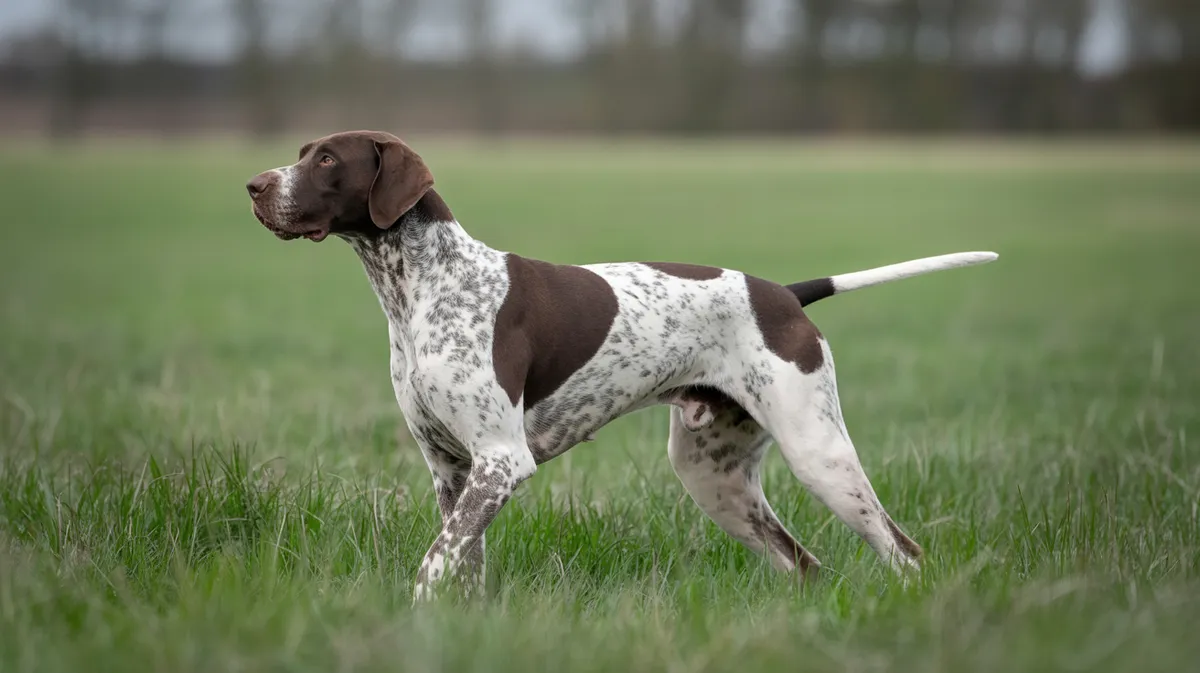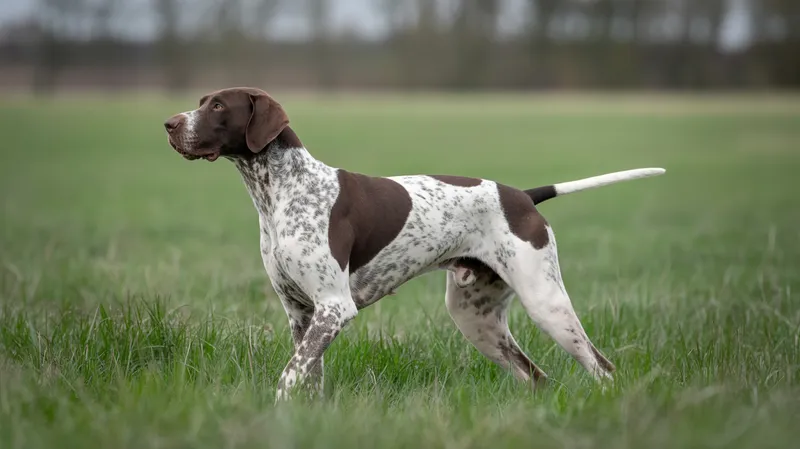
Pointer (English)
Canis lupus familiaris

Meet the Pointer (English)
The Pointer (English), commonly referred to simply as the Pointer, is a medium-to-large breed of dog originally developed in England for hunting and pointing game birds. Renowned for its athleticism and graceful stance, the breed is characterized by a lean, muscular body, a long neck, and a distinctly straight tail that is held level to the back when 'pointing.' Pointers are highly energetic, intelligent, and affectionate companions, excelling in both fieldwork and as family pets. Their short, smooth coat comes in a variety of colors, most commonly white with liver, lemon, black, or orange markings.
Classification
Mammal
Habitat
Domestic; rural and suburban areas with open fields
Diet
Omnivore
Lifespan
12-17 years
Conservation
Not Evaluated
Weight
20-34 kg (44-75 lbs)
📖Fascinating Facts
Natural Pointer
English Pointers exhibit the signature 'pointing' stance instinctively, even as puppies, without specific training.
Remarkable Stamina
Pointers are bred for endurance and can cover large distances at speed, making them ideal partners for active owners.
Exceptional Sense of Smell
Their highly developed olfactory senses enable them to detect game birds from great distances.
📋Detailed Description
The English Pointer is a medium-to-large sporting dog, typically standing 58–71 cm (23–28 in) at the shoulder and weighing 20–34 kg (45–75 lbs), with males generally larger than females. Its anatomy is optimized for speed and endurance: a deep chest allows for efficient lung expansion, while long, straight forelimbs and powerful hindquarters provide a ground-covering stride. The head is proportionate with a pronounced stop, wide nostrils for scent detection, and expressive, almond-shaped eyes. The breed's short, dense coat is low-maintenance and provides some protection against brush and weather, while its coloration—most commonly white with liver, lemon, black, or orange patches—offers camouflage in open fields. Pointers are renowned for their keen olfactory senses, capable of detecting game birds at considerable distances. Their iconic 'point' stance—body rigid, tail level, and one foreleg raised—signals the presence of prey to hunters. Socially, Pointers are affectionate and thrive in human company, often forming strong bonds with family members and other dogs. They are highly trainable, intelligent, and require significant mental and physical stimulation. Their athletic build and stamina make them exceptional competitors in field trials and agility sports.
💡 Did you know?
Despite their prowess in the field, English Pointers are known to be sensitive and thrive on positive reinforcement and companionship.
🔬Research & Sources
🎭Behavior & Social Structure
English Pointers are energetic and require regular, vigorous exercise, often thriving in environments where they can run off-leash. Their hunting behavior is characterized by quartering fields methodically, using their acute sense of smell to locate and indicate game birds without flushing them. In the home, they are generally gentle, sociable, and eager to please, though their high energy can lead to restlessness if not adequately exercised. Pointers are known for their even temperament and adaptability, making them suitable for both working and companion roles. They display strong pack instincts, often integrating well with other dogs. Daily routines typically include bursts of high activity, such as running or playing, interspersed with periods of calmness and close human interaction. They are not prone to aggression but may be reserved with strangers, exhibiting alertness without excessive barking.
👶Reproduction & Life Cycle
The English Pointer reaches sexual maturity between 8 and 12 months, though responsible breeding is typically delayed until at least 2 years of age to ensure physical and behavioral maturity. The breed is monoestrous, with females coming into heat approximately twice a year. Mating is usually natural, though artificial insemination is sometimes used in breeding programs. Gestation lasts about 63 days, after which litters of 4–9 puppies are born. Neonates are altricial, requiring intensive maternal care for the first weeks. Both breeders and owners often provide supplemental care, including early socialization and environmental enrichment. Weaning begins at 3–4 weeks, with puppies typically rehomed at 8–10 weeks. There is no defined breeding season, as domestic dogs can breed year-round, though many breeders plan litters for spring or summer for optimal conditions.
🛡️Adaptations & Survival
The Pointer’s physical adaptations are the result of centuries of selective breeding for fieldwork. Its lean, aerodynamic body and long legs facilitate rapid, sustained running, while a deep chest supports cardiovascular endurance. The breed’s olfactory system is highly developed, with large nasal passages and a high density of olfactory receptors, enabling detection of faint scents over long distances. The characteristic 'point' stance is a behavioral adaptation, allowing the dog to freeze and indicate prey location without startling it. Their short, smooth coat minimizes drag and overheating during exertion. Behaviorally, Pointers exhibit high trainability, focus, and a strong desire to work cooperatively with humans, all traits that have been reinforced through generations of selective breeding for hunting efficiency.
📚Research Sources
🎨Cultural Significance
The English Pointer has played a prominent role in British and European hunting culture since at least the 17th century, often depicted in art and literature as the quintessential bird dog. Its image is associated with elegance, athleticism, and partnership with humans in the field. The breed has been featured in works by artists such as George Stubbs and in classic sporting literature. Beyond hunting, Pointers are valued as family companions and have excelled in dog sports, including field trials, obedience, and agility. Their keen senses and trainability have occasionally seen them used in search-and-rescue and detection roles. The breed symbolizes precision, reliability, and the human-canine bond in sporting contexts.
🔬Recent Research & Discoveries
Recent genetic studies have explored the Pointer’s ancestry, confirming its close relationship to other British and continental pointing breeds, with possible contributions from Spanish Pointers and Foxhounds. Ongoing research focuses on the genetic basis of inherited diseases, aiming to improve health screening protocols. Behavioral studies have examined the breed’s olfactory capabilities and the neurological mechanisms underlying the 'point' stance, revealing complex interactions between instinct and learned behavior. Advances in canine sports medicine have provided insights into optimal training regimens and injury prevention for athletic breeds like the Pointer. The breed is also included in broader studies on canine cognition, social behavior, and the effects of domestication.
🎥Wildlife Videos

THE ENGLISH POINTER No2.The Evolution. Hunting Working, Morphology, History
POINTING DOGS N07 A TSTV Production. Scenario & Directing Giannis Christogiannis 12 years after our first movie regarding ...
ioannis christogiannis

English Pointer finds a big Sambar deer stag
Maximising your sambar deer hunting success by buying a pointing dog to find deer really comes down to understanding how to ...
Ultimate Hunting Australia

Vet Helps Pregnant Dog Give Birth To 10+ Puppies 🥹 8hrs Natural Birth | Bondi Vet Clips | Bondi Vet
No one knew Jewel was pregnant! Get ready for a long night of anxiety, sadness and ultimately joy as Dr Chris helps Jewel ...
Bondi Vet

Film 31: Marlborough Eight Pointer
Hunting Red Stags in the roar on public land in Marlborough. A lot of Chamois seen, but no Deer located until the last day of the ...
PATHFilmsNZ

dogs hurry for hunt dogs, hunting dog, village dogs, pointer dog,
Hunting dogs Real,
wildlife animals of sindh
🌍Habitat Information
The Pointer (English) typically inhabits Domestic; rural and suburban areas with open fields environments. Pointer (English)s have adapted to their environments with specialized features and behaviors.
Primary Habitat:
Domestic; rural and suburban areas with open fields
More detailed habitat information will be available soon.
🛡️Conservation Status
The Pointer (English) is currently classified as Not Evaluated. Conservation efforts are crucial for preserving this species for future generations.
Common Threats:
- 🏠Habitat loss and fragmentation
- 🌡️Climate change impacts
- 🎯Hunting and poaching
- 🏭Human-wildlife conflict
⚠️Threats & Conservation Challenges
As a domesticated breed, the English Pointer faces few threats in terms of wild population decline. However, challenges include genetic bottlenecks due to selective breeding, which can predispose the breed to inherited conditions such as hip dysplasia, progressive retinal atrophy, and autoimmune disorders. Overbreeding and irresponsible breeding practices may exacerbate these issues. In some regions, declining interest in traditional field sports has led to reduced demand for working Pointers, though the breed remains popular in companion and competitive roles. There are no significant conservation concerns, but breed clubs and organizations emphasize health screening and responsible breeding to maintain genetic diversity and overall health.
🔬Scientific Classification
Scientific Name
Canis lupus familiaris
Classification Hierarchy
🔍 About Taxonomic Classification
Taxonomic classification is a hierarchical system used by scientists to classify and organize living organisms based on shared characteristics and evolutionary relationships.
The system moves from broad categories (Kingdom) to increasingly specific ones, with each animal's scientific name typically consisting of its Genus and species.
📝Community Notes
Share your observations and insights about the Pointer (English) with our community of wildlife enthusiasts.
Join Our Community
Sign in to share your observations and connect with fellow wildlife enthusiasts.
Sign In to ContributeNo community notes yet
Be the first to share your observations about the Pointer (English)!
Explore Pointer (English)
Select a tab above to learn more about this amazing animal.
📸Photo Gallery
No photos available for this animal yet.
🌟Discover More Wildlife
Continue your journey of discovery with more fascinating animals from our database
